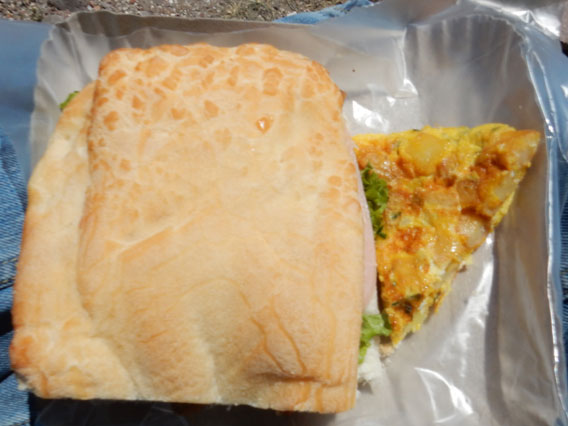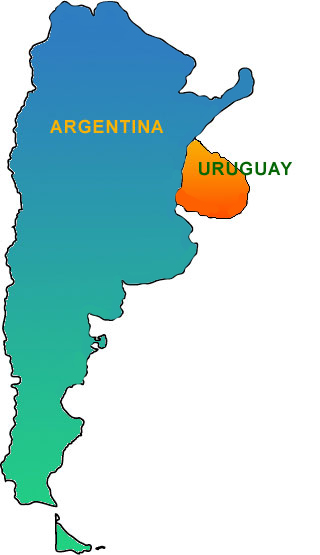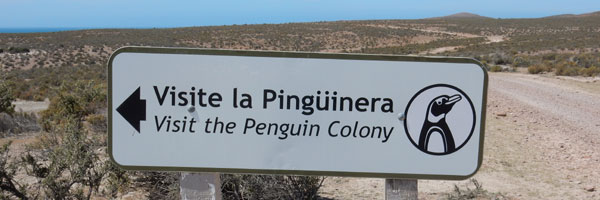24,000 Penguins
Early morning in Patagonia, sitting on the beach. Such a different world from Buenos Aires. I went for a walk along the rocky shore below our houses, exploring the tidepools and watching the sunrise. There are a lot of beautiful shorebirds here, including cormorants, giant petrels, and oystercatchers, making their way up and down the dramatic and austere Patagonian coast.
Jesse and I figured out the stove and the rudimentary way of making coffee, an important necessity to me first thing in the morning. After coffee, Jesse, Jet, and I went over to the women's house and had scrambled eggs, reheated empanadas, and fresh fruit. We sat around the big table and compared notes on our early impressions of Patagonia. It was a nice way to prepare for our first day in the field.
Just before 9:00am, we all piled into the van and left Camarones for an hour-long drive on dirt roads through the Patagonian desert. The penguin colony that we are monitoring is located in a provincial park, about 30 kilometers south of Camarones. As we drove through the desert, we began to get an indication of what a wild and exciting place this really is.
Herds of guanacos (Lama guanicoe), an undomesticated cousin of the llama, grazed in the rolling hills just off the road. A couple of rheas (Rhea americana) went running by, dashing across the road and up into a ravine. This large flightless bird, known as choique in Spanish, is related to the ostrich and can be found through much of the southern part of South America. Martinetas (Eudromia patagonica), a medium-sized bird resembling a pheasant, could be seen scurrying across the road right in front of the van.
We arrived at the penguin colony, a spectacular park known as Cabo Dos Bahias, or "Cape of Two Bays." We piled out of the van to gaze out in wonder at the scene spread out before us. The red rocks of the desert stood out in stark contrast to the deep blue of the sea beyond. A herd of guanacos grazed along a ridgetop, forming dramatic silhouettes against the sky. But the sight that really had us transfixed was the vast network of penguin nests, spread out every three or four feet across the desert. This colony has about 12,000 breeding pairs of Magellanic penguins, 24,000 penguins in all.
Penguins waddled around among the nests, sometimes in pairs, mostly solitary. A long raised metal walkway went down the hill and through the colony, protecting the fragile nests from the footsteps of visitors. We gathered up all our equipment and broke up into three groups, then set out into the colony.
Of the 12,000 nests in the colony, 252 of them have been marked for this research project. Our job is to check the nests each day, count the number of eggs (always zero, one, or two), and record whether the penguin is male or female. Since this was the first day, we also had to record GPS coordinates for each of the nests as we walked around the colony.
We quickly became aware of the sensitive habitat of the Magellanic penguins, including the predators and dangers they have to face. Armadillos (Chaetophractus villosus) scurried throughout the colony, going from nest to nest to see if they could find any unguarded eggs. The actual name of this species is big hairy armadillo, a most appropriate name given the dense bristly hairs that cover the underside of its body. Known in Argentine Spanish as a peludo (hairy) or mulita (little mule), these voracious predators are one of the biggest dangers faced by the penguins and their eggs. Overhead are other predators, such as skuas (Stercorarius antarcticus), known in Spanish as escuas. They swoop down menacingly, sometimes going after vulnerable penguins, other times devouring the eggs.
In the early afternoon, we took a lunch break, meeting back at the van in the parking lot. Lunch was hearty home-cooked fare, picked up each morning from a local cook in Camarones. On this day we had a nice ham and cheese sandwich with a small slice of tortilla on the side. As in Spain, the word tortilla means omelette in Argentine Spanish, rather than the Mexican meaning of a round flat type of bread.

A ham and cheese sandwich, with a tortilla on the side, a hearty lunch in the field
After lunch, we went back out into the colony to finish our rounds of the nests. Lynn showed us the skeleton of a guanaco that she had happened upon and several of us stopped to take pictures. We looked up to find that the herds of guanacos had moved closer, eyeing us suspiciously as we examined their fallen colleague. Maybe this was a sacred guanaco graveyard, a revered site that we should not be desecrating. We made a quiet and respectful retreat.
By late afternoon I was in Zone 4 with Romi, Jet, and Leslie. This is the furthest part of the colony from the parking lot, well beyond the end of the protective walkway. We walked down the rocky slope to the water's edge, where a small channel separated the mainland from Isla Moreno. The island was just 100 meters away and home to a large colony of South American sea lions (Otaria flavescens). The boisterous pinnipeds made a raucous noise that carried across the channel with the wind. Many of the sea lions spotted us from a distance and immediately jumped in the water out of curiosity. They crossed about half way across the channel, cautiously approaching us as we sat on the shore. Their heads bobbed up and down in the water, watching us with fascination, while we returned the favor and watched them back, entralled with their antics.
After we got back to Camarones, we had a little free time for napping, showering, and exploring around the beach. Then at 8:30, we went back to Alma Patagónica, our regular hangout for dinner. That night we had a delicious lamb stew with vegetables, boiled potatoes, and homemade bread. It was a great way to end the day and learn more from the researchers about our plans for the next day.
| Next up: How to ID a Penguin |


© 2016 Michael Hanrahan